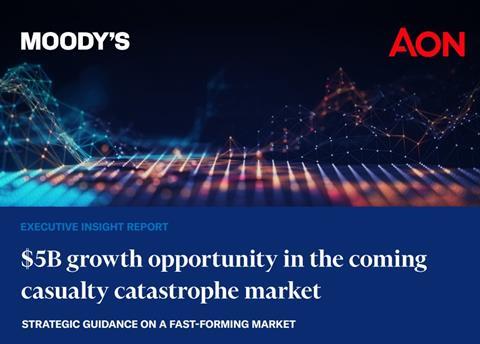Casualty cat has reached an inflection point, where a structured, scalable market is rapidly emerging, according to new research from Aon and Moody’s

Emerging liability risks are reshaping the casualty reinsurance market, according to a new report from Aon and Moody’s, projecting that systemic litigation trends could generate around $5bn of annual reinsurance premium opportunity.
The study, “The new era of casualty risk,” warns that long-tail exposures such as PFAS contamination, addictive social media design, microplastics and ultra-processed foods are driving claims volatility, testing reserving models and challenging re/insurers to adapt.
Between 2014 and 2022, the US alone experienced two to three new mass torts each year, according to Moody’s CoMeta platform.
Once rare, these events now occur with increasing regularity, producing losses on the scale of natural catastrophes.
Litigation financing and sophisticated plaintiff-side strategies are making previously improbable lawsuits viable, pushing casualty insurers into territory that resembles property catastrophe dynamics.
Amanda Lyons, global product leader at Aon’s reinsurance solutions business, described the sector as “at an inflection point”.
“We are not just responding to these market changes – we are developing and implementing advanced solutions in order to proactively shape a scalable, structured market that is poised for substantial growth,” she said.
“Supported by our insights and technology, we are encouraging reinsurers and other capital providers to allocate capacity to these risks and help drive the development of innovative products,” Lyons added.
From isolated shocks to systemic crises
Historically, catastrophic casualty losses were isolated and manageable. Today, mass litigation has become correlated and systemic.
The report notes that six of the 13 largest loss events in the US property and casualty industry have been casualty-driven, while deficient reserving in liability lines remains the leading cause of insurer impairment.
Legal arguments, evolving science and heightened jury awards are extending latency periods and worsening reserve volatility, the report’s authors warn.
Public nuisance claims, multi-district litigation and the ready availability of plaintiff funding have outpaced traditional tort reforms, eroding insurers’ ability to rely on caps or class action limits.
Joe Melly, managing director for casualty and financial lines at Moody’s, said: “Through advanced analytics, AI-enabled casualty catastrophe modeling, and targeted named peril reinsurance products, we are converting emerging casualty exposures into tangible opportunities for re/insurers.
“This work reflects Moody’s deep commitment to fostering a more sustainable, data-driven, and resilient casualty market,” Melly said.
Innovation and reserving
To meet these challenges, Aon and Moody’s said they have been developing “named peril” casualty reinsurance.
Unlike broad traditional covers, named peril contracts offer targeted protection against specific exposures, such as microplastics or addictive technology platforms, allowing reinsurers and capital providers to ring-fence liabilities and price them more transparently.
The report argues that such products can reduce reserving uncertainty, improve capital efficiency and mobilise defence resources for defendants facing well-funded litigation. They also provide a foundation for a structured casualty catastrophe market akin to the evolution of property cat in the late twentieth century.
Another innovation is in so-called latency reserving, which explicitly sets aside capital for emerging risk exposures.
By dividing incurred-but-not-reported reserves into conventional and latency buckets, insurers can stabilise estimates, cut volatility and support growth. Latency reserving also stimulates runoff transactions and legacy liability transfers, which the report identifies as another growth avenue for the casualty cat segment.
Strategic opportunities
With mass litigation risks proliferating and traditional approaches proving inadequate, the Aon/Moody’s analysis concludes that a structured casualty catastrophe reinsurance market is inevitable. Early estimates place its size at $5bn annually, with further expansion potential from legacy deals and parametric structures.
For reinsurers, the strategic question is not whether the market will emerge, but who will lead its development. Those that adopt advanced modelling, data-driven underwriting and innovative transfer solutions stand to benefit most.
“The casualty catastrophe sector has reached an inflection point, where a structured, scalable market is rapidly emerging,” Lyons added.










No comments yet